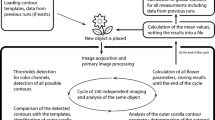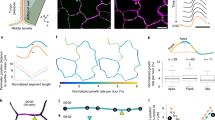Abstract
A non-destructive method for scanning electron microscopy allows individual developing flower surfaces to be imaged sequentially. Kinematic analysis, the quantitative characterization of expansion behavior, can be applied to consecutive images of the same primordium. The individual cell, delimited as a polygon by its anticlinal walls, is the unit of analysis. Growth in two dimensions is characterized by a right-angle cross giving the maximal and minimal rates of extension relative to a known side of the cell. Methods have been developed here to make the analysis rapid and the results easy to portray. Data were obtained for the flower primordium of Anagallis arvensis L. from its origin as a smooth dome through the development of five small stamens and an incipient gynoecium. The outermost sepal whorl arises synchronously as a fivefold undulation. This maneuver is closely coupled to the formation of five stamen buttresses alternating with the small sepals (petals form later). The most characteristic kinematics occur as the stamen buttresses expand rapidly at their tips. The sides of the buttresses, and the regions between them, show highly directed extension following the five radii of the flower. These unique expansions are associated with the origin of the filament as a stalked structure and also correlate with the future bilateral symmetry of the anther. The region interior to the stamens grows slowly as circumferentially oriented anticlinal divisions initiate a radial cell-file pattern for the gynoecium. The developmental sequence has many features of “feed-forward” where the previous structure is important for the generation of structure to come (e.g. stamens alternate precisely with sepals). Some of these features fit plausible biomechanical explanations for morphogenesis.
We wish to thank Mr. N. Rasmussen, Department of Biology, Stanford University, for providing Fig. 1A, B. Use of the SEM facility of Professor G. Goffinet, Institute of Zoology, University of Liège, is greatly appreciated. We thank Dr. R. Jacques, C.N.R.S., Le Phytotron, Gif-sur-Yvette, France, for providing the experimental material, and Mr. Philippe Ongena and Dr. Suresh Tiwari for expert photography. Support was from grants from the U.S. Department of Agriculture and National Science Foundation and as well as from the Fonds National de la Recherche Scientifique, Fonds de la Recherche Fondamentale et Collective and the “Action de Recherche Concertée” of Belgium.
Similar content being viewed by others
Abbreviations
- SEM:
-
scanning electron microscope/micrographs
References
Avery, G.S., Jr. (1933) Structure and development of the tobacco leaf. Am. J. Bot. 20, 565–592
Bowman, J.L., Smyth, D.R., Meyerowitz, E.M. 91989) Genes directing flower development in Arabidopsis. Plant Cell 1, 37–52
Brulfert, J., Fontaine, D., Imhoff, C. (1985) Anagallis arvensis. In: Handbook of flowering, vol. 1, pp. 434–449, Halevy, A.H., ed. CRC Press, Boca Raton, Fla., USA
Carpenter, R., Coen, E.S. (1990) Floral homeotic mutations produced by transposon-mutagenesis in Antirrhinum majus. Genes Devel. 4, 1483–1493
Cummings, F.W. (1990) A model of morphogenetic pattern formation. J. Theor. Biol. 144, 547–566
Gerhart, J., Danilchick, T., Doniach, S., Roberts, B., Stewart, R. (1989) Cortical rotation of the Xenopus egg: consequences for the anteriorposterior pattern of embryonic dorsal development. Development 1989, Supp., 37–51
Goodall, C.R., Green, P.B. (1986) Quantitative analysis of surface growth. Bot. Gaz. 147, 1–15
Goodwin, B.C., Kauffman, S.A. (1990) Spatial harmonics and pattern specification in early Drosophila development. I. Bifurcation sequences and gene expression. J. Theor. Biol. 144, 303–319
Gould, K.S., Lord, E.M. (1989) A kinematic analysis of tepal growth in Lilium longiflorum. Planta 177, 66–73
Green, P.B. (1973) Morphogenesis of the cell and organ axis — Biophysical models. In: Basic mechanisms in plant morphogenesis (Brookhaven Symp. in Biol. 25), pp. 166–190. Brookhaven National Laboratory, Upton, N.Y., USA
Green, P.B. (1984) Analysis of axis extension. In: Positional controls in plant development, pp. 53–82, Carr, D.J., Barlow, P., eds. Cambridge University Press, Cambridge, UK
Green, P.B. (1988) A theory for inflorescence development and flower formation based on morphological and biophysical analysis in Echeveria. Planta 175, 153–169
Green, P.B., Brooks, K. (1978) Stem formation from a succulent leaf: its bearing on theories of axiation. Am. J. Bot. 65, 13–26
Green, P.B., Poethig, R.S. (1982) Biophysics of the origin and extension of plant axes. In: Developmental order: Its origin and regulation, pp. 485–589, Green, P.B., Subtelny, S., eds. Alan Liss, New York
Holder, N. (1979) Positional information and pattern formation in plant morphogenesis and a mechanism for the involvement of plant hormones. J. Theor. Biol. 77, 195–212
Ingber, I.E., Folkman, J. (1989) Tension and compression as basic determinants of cell form and function: utilization of a cellular tensegrity mechanism In: Cell shape. Determinants, regulation and regulatory role, pp. 3–31, Stein, W.D., Bronner, F., eds. Academic Press, San Diego, Cal., USA
Irish, V.F., Sussex, I.M. (1990) Function of the apetala-1 gene during Arabidopsis floral development. Plant Cell 2, 741–753
Koltunow, A.M., Truettner, J., Cox, K.H., Wallroth, M., Goldberg, R.B. (1990) Different temporal and spatial gene expression patterns occur during anther development. Plant Cell 2, 1201–1224
Kunst, L., Klenz, J.E., Martinez-Zapater, J., Haughn, G.W. (1989) AP-2 gene determines the identity of perianth organs in flowers of Arabidopsis thaliana. Plant Cell 1, 1195–1208
Kutschera, U. (1989) Tissue stresses in growing plant organs. Physiol. Plant. 77, 157–163
Marc, J., Hackett, W.P. (1989) A new method for immunofluorescent localization of microtubules in cell surface layers: application to the shoot apical meristem of Hedera. Protoplasma 148, 70–79
Meinhardt, H. (1982) Models of biological pattern formation. Academic Press, London, UK
Melchers, G. (1937) Die Wirkung von Genen, tiefen Temperaturen und blühenden Pfropfpartnern auf die Blühreife von Hyocyamus niger Biol. Zbl. 57, 568–614
Meyerowitz, E.M., Bowman, J.L., Brockman, L.L., Drews, G.N., Jack, T., Sieburth, L.E., Weigel, D. (1991) A genetic and molecular model for flower development in Arabidopsis thaliana. Development, Suppl. 1 (in press)
Sakaguchi, S., Hogetsu, T., Hara, N. (1990a) Arrangement of cortical microtubules at the surface of the shoot apex in Vinca major L.; observations by immunofluorescence microscopy. Bot. Mag. Tokyo 101, 497–507
Sakaguchi, S., Hogetsu, T., Hara, N. (1990b) Specific arrangements of cortical microtubules are correlated with the architecture of meristems in shoot apices of angiosperms and gymnosperms. Bot. Mag. Tokyo 103, 143–163
Schwarz-Sommer, Z., Huijser, P., Nacken, W., Saedler, H., Sommer, H. (1990) Genetic control of flower development by homeotic genes in Antirrhinum majus. Science 250, 931–936
Silk, W.K. (1984) Quantitative descriptions of plant development. Annu. Rev. Plant Physiol. 35, 497–518
Szilard, R. (1974) Theory and analysis of plates. Classical and numerical methods. Prentice Hall, Englewood Cliffs, N.J., USA
Went, F.W. (1957) The experimental control of plant growth. Chronica Botanica, Waltham, Mass., USA
Williams, M.H., Green, P.B. (1988) Sequential scanning electron microscopy of a growing plant meristem. Protoplasma 147, 77–79
Author information
Authors and Affiliations
Additional information
L.F. Hernández is a member of the Scientific Career of the Comisión de Investigaciones Científicas (CIC), La Plata, Argentina. The financial help provided to L.F. Hernández by Fundación Antorchas, Buenos Aires, Argentina is gratefully acknowledged.
Rights and permissions
About this article
Cite this article
Hernández, L.F., Havelange, A., Bernier, G. et al. Growth behavior of single epidermal cells during flower formation: Sequential scanning electron micrographs provide kinematic patterns for Anagallis . Planta 185, 139–147 (1991). https://doi.org/10.1007/BF00194054
Accepted:
Issue Date:
DOI: https://doi.org/10.1007/BF00194054




